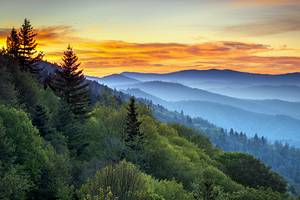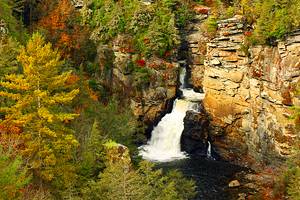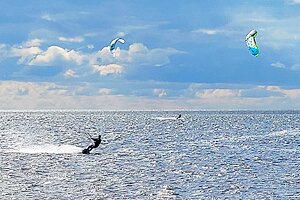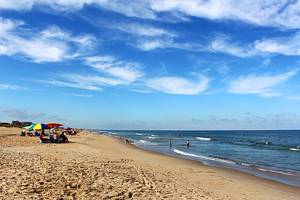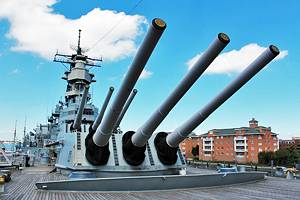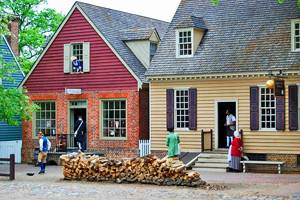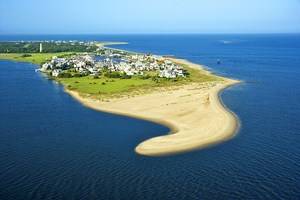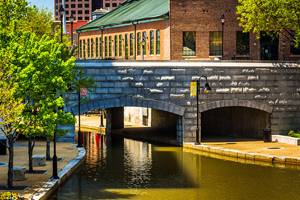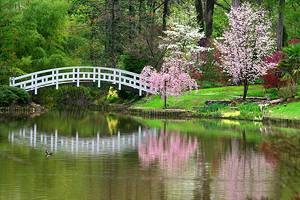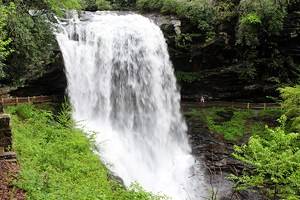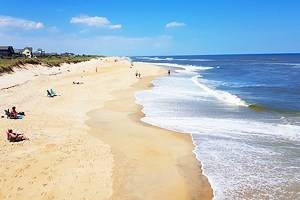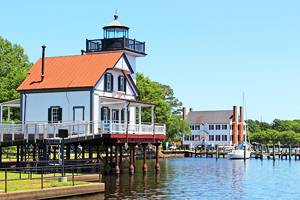Attractions & Things to Do in the Outer Banks, NC
Author Michael Law is an avid kiteboarder and enjoys spending time on the beaches of the Outer Banks.
The Outer Banks are a seemingly endless stretch of sun, sand, and surf. The list of things to do along the Outer Banks of North Carolina is extensive and packed with exciting adventures.
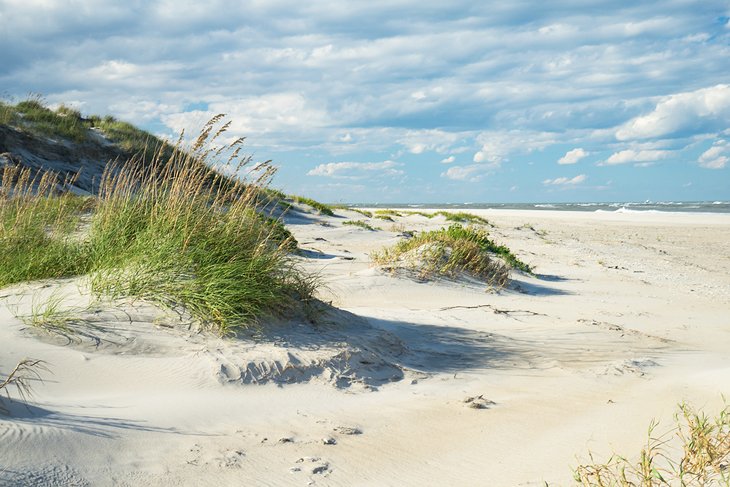
The Outer Banks are barrier islands that stretch for more than 100 miles along the Atlantic Coast, connected by a series of bridges and towns that are popular vacation destinations. The Outer Banks has some of North Carolina's best coastal towns and sun-seekers make an annual pilgrimage on family vacations to places like Duck, Kill Devil Hills, Nags Head, Rodanthe, and Hatteras, taking advantage of the many vacation home rentals and lodging available.
Plan your fun-filled adventure with our list of the best places to visit and things to do in the Outer Banks.
Lounge on the Beaches
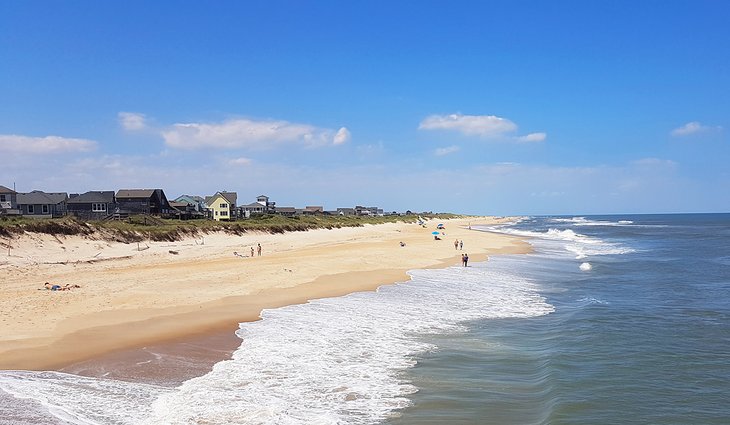
The main reason people have been coming to the Outer Banks since the early 1920s is to enjoy the world-class beaches. Stretching for miles and miles, these wide beaches lapped by the Atlantic Ocean are some of the best beaches in North Carolina.
Miles and miles of sand and fun towns provide endless opportunities for recreation and good times. A special feeling envelopes you when you cross over the long bridges from the mainland and arrive in a place that's all about sun and sand.
You'll have no problem finding your own patch of sand to do your own thing out here. Access to the beaches, whether they are in the center of town or more isolated, is easy, with boardwalks or paths through the dunes. However, parking can be challenging on the busiest of weekends.
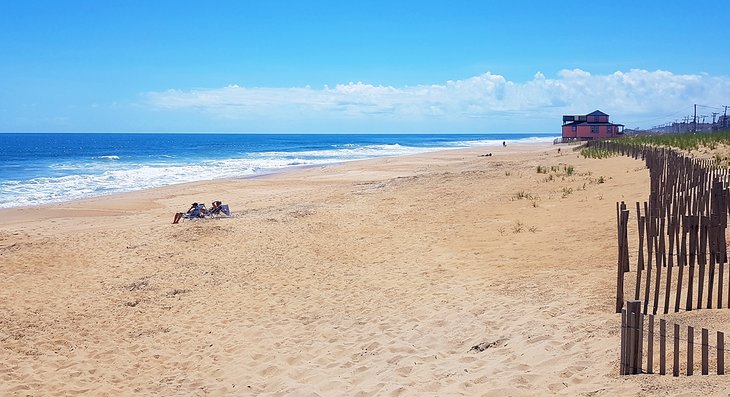
Surfing, boogie boarding, swimming, and playing in the waves are some of the regular pastimes. Shore fishing and shell hunting are other options. For those looking for something a bit more adventurous, the adrenaline-fueled sport of kiteboarding is also popular here near the towns of Waves and Salvo. Come the evening, catch sunset over a beach fire (where permitted) as you listen to the waves roll in.
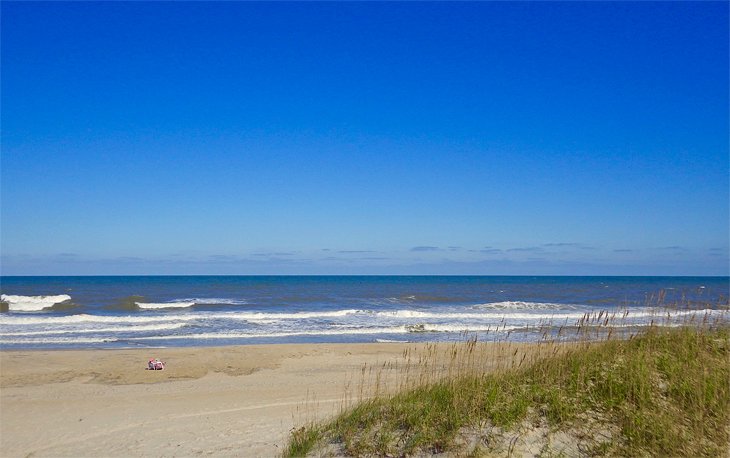
Some of the best beaches on the Outer Banks are along the Cape Hatteras National Seashore, at the southern end of the Outer Banks. This area stretches more than 70 miles along the coast, and you'll find many roadside public pull-offs along N.C. Highway 12 with beach access. Many access areas have restrooms, changing buildings, and scenic lookouts with important visitor and swimming information posted.
Climb to the Top of Historic Lighthouses
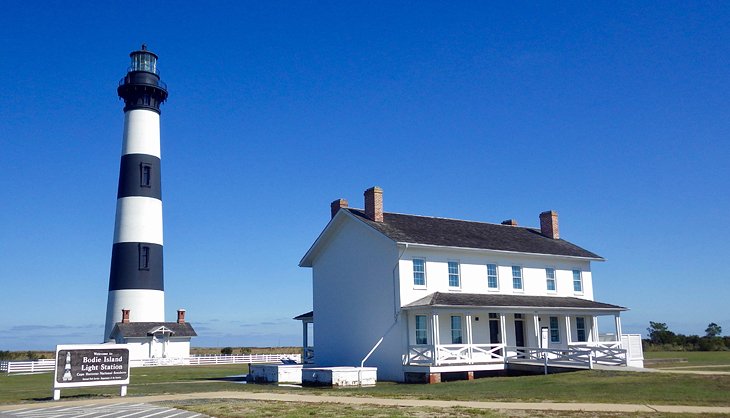
There are five lighthouses on the Outer Banks that most tourists like to check off their must-do list: Cape Hatteras Lighthouse, Bodie Island Lighthouse, Roanoake Marshes Lighthouse, Currituck Beach Lighthouse, and Ocracoke Lighthouse.
The Cape Hatteras Lighthouse, considered a tall tower since it stands higher than 150 feet, is the tallest brick lighthouse in North America, with spiraling black and white stripes all the way up its 208-foot tower.
The Cape Hatteras lighthouse was moved back a half mile in 1999. You can walk the path to see the original location — a sandy beach that is now covered with ocean waves and is a popular spot for surfers. The Bodie Island Lighthouse, also referred to as a tall tower, is still operational, navigating boats to shore with its 19-mile beam of light. The 156-foot-tall lighthouse is identified by its horizontal stripes.
The Roanoke Marshes Lighthouse in Manteo on Roanoke Island is a small but fun find for those who love to visit lighthouses. It is a replica of the original 1877 lighthouse and smaller than the others in the Outer Banks.
Currituck Beach Lighthouse is a tall tower at 158 feet and popular for climbing during seasonal hours, and the Ocracoke Lighthouse (75 feet) is the second-oldest operating lighthouse in the United States. Most of the lighthouses, except for Ocracoke Lighthouse, are open to climbing from April through Columbus Day.
Camp near the Beach
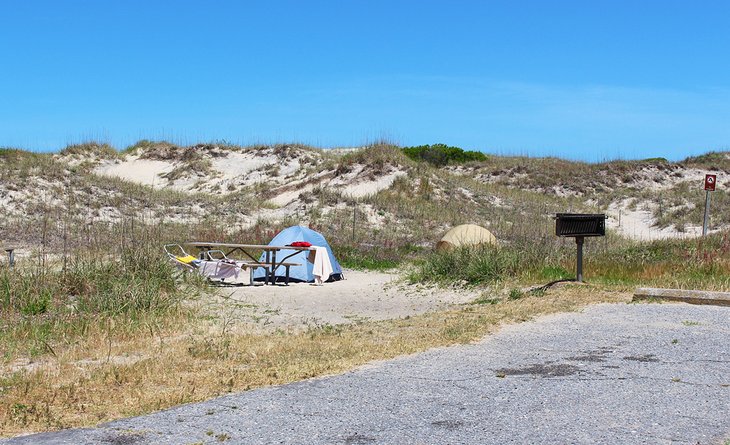
One of the greatest ways to experience the Outer Banks without busting the bank account is to camp in the Outer Banks. Campgrounds here are mere steps from the surf and are equipped to make your experience one to remember. Depending on where you camp, your days will likely be filled with sun and sand, while the evenings are spent quietly around a roaring beach fire.
It doesn't matter whether you are in the smallest tent or the biggest RV, the Outer Banks campgrounds have you covered. Options for camping include fantastic national parks with limited facilities but in great locations, right through to commercial campgrounds in the center of the action, equipped with pools, hot tubs, and dog parks.
If you really want to camp on the beach on an almost deserted island, book a ferry ride to Portsmouth Island and find your own spot in among the dunes. Perhaps camping near a lighthouse is of more interest? In that case, check out Cape Point Campground. If offshore fishing is your thing, and you have your boat with you, definitely plan to stay at Oregon Inlet.
Pack all your beach gear and get out there! Camping is available all the way up and down the Outer Banks — but plan ahead and book a site — places fill up during the summer months well in advance.
See the Wright Brothers National Memorial

The Wright Brothers National Memorial in Kill Devil Hills commemorates the birthplace of flight.
It was here where the Wright Flyer lifted from the sands of the Outer Banks for 12 seconds before setting back down and forever changing aviation in the United States in December of 1903. Learn about how this first powered flight by Orville and Wilbur Wright altered transportation and see a full-scale replica of the Wright Flyer.
The visitor center has interpretive programs, exhibits, and sculptures dedicated to this historic moment. Plan some time to visit all of the exhibits and explore the grounds as you make your way to the First Flight Boulder, which marks the exact location where the plane left the ground during the first flight. There is an admission fee, but if you have a National Parks Pass, it's free.
Address: 1005 N. Croatan Highway, Kill Devil Hills, North Carolina
Play in the Sand Dunes at Jockey's Ridge State Park
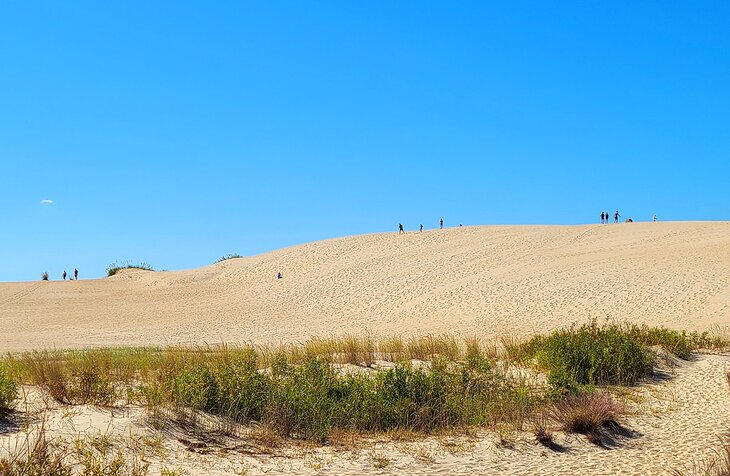
Take off your shoes and plan an unforgettable walk along the tallest active natural sand dune on the East Coast at Jockey's Ridge State Park. The mammoth dune reaches up to 100 feet high, depending on the gusts of wind.
The expansive landscape seems otherworldly as you walk higher and farther into a mirage of never-ending sand. You will likely see people hang-gliding from the dune as it is home to the largest hang-gliding school in the world.
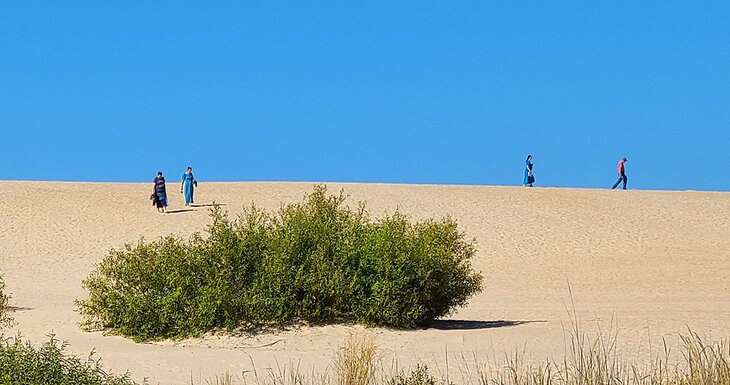
From the peak, you can see the ocean on one side and Roanoke Sound on the other, with an ever-changing scene in between. Everyone experiences the grand dune in their own way, with picnics, walks, twirls in the wind, or a romantic kiss at the top.
The visitor center explains how the natural dune formed over the years, and the adjacent boardwalk is an educational way to learn about the dune's ecology and wildlife. Plan to take water and sunscreen with you if you walk out to the dune field.
Address: 300 W. Carolista Drive, Nags Head, North Carolina
Go Kiteboarding
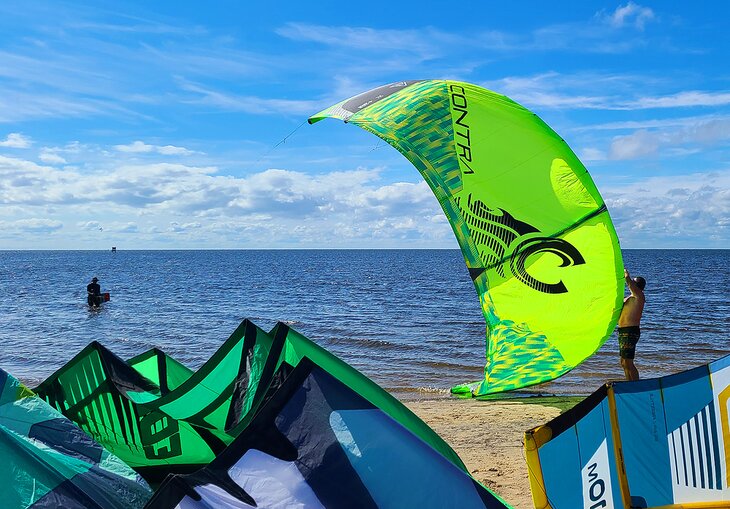
North Carolina's Outer Banks are one of the best kiteboarding destinations in the United States. Strong steady winds buffet these low islands throughout the year making for ideal conditions to pursue not only kiteboarding, but also the relatively new sport of winging and the historical sport of windsurfing. When you combine the wind with shallow, generally calm water, it's a paradise for adrenaline junkies.
Most of the kiteboarding takes place on Pamlico Sound from the town of Waves down to Hatteras Island. Easy access points, shallow water, and miles of wide-open riding coupled with famous downwinder routes make kiteboarding here legendary. Check out Salvo Day Use Area and The Cut for regular riding, and if you have the skill set, take on the Planet of the Apes downwinder.
Retail shops and services support the sport and accommodation can be found in hotels, rental homes, or campgrounds. For more complete details, have a read through our article on Kiteboarding in the Outer Banks: What to Know & Where to Go.
Visit Jennette's Pier
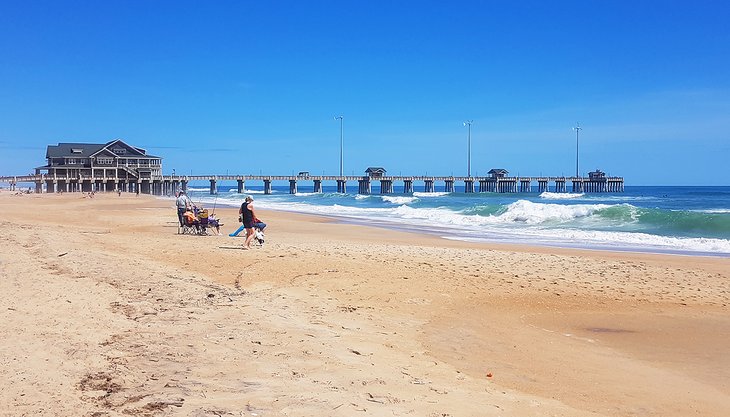
Jennette's Pier in Nags Head is one of the must-visit piers during your stay, although there are several that will likely call your attention with unique features. Jennette's Pier is a stand-out because it is powered by the wind, as evidenced by the windmills on it.
The massive pier stretches 1,000 feet into the Atlantic and is a popular fishing pier and aquatic educational center operated by the North Carolina Aquariums with regular public demonstrations.
The other Outer Banks piers worthy of a visit or sunset viewing spot are the Nags Head Pier, Rodanthe Pier, which is popular for fishing and offers fishing equipment rentals; and Avalon Pier, the liveliest spot in town.
Address: 7223 S. Virginia Dare Trail, Nags Head, North Carolina
Stroll on Duck Town Boardwalk
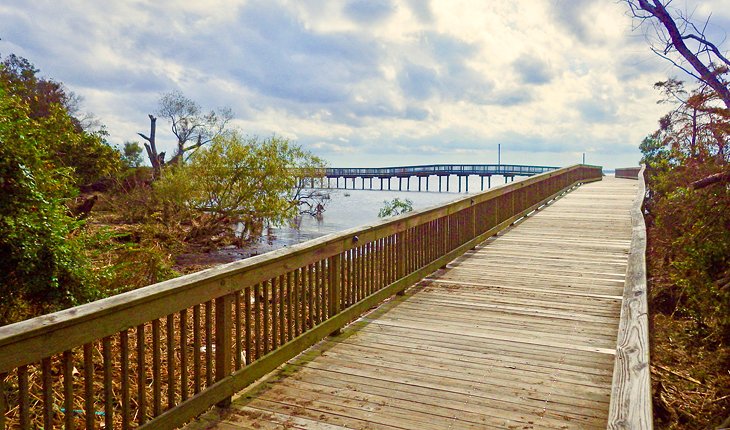
The town of Duck is a walkable and bike-friendly area with shopping, restaurants, and a famous boardwalk. It is a perfect option for families with kids and for those who prefer to spend more time looking at the beach as opposed to being on the sand.
The boardwalk is in the center of town, stretching about a mile, with places to visit for a bite to eat or just to sit and relax near the water.
The best access point for the boardwalk is at Town Park, where you can also enjoy nature trails, green space, a willow swamp, and a maritime forest. Walk the boardwalk near dusk and catch one of the best sunset views in all of the Outer Banks.
For a fine meal at the start or end of your boardwalk stroll, stop in at AQUA for the freshest seafood around — try and score a spot on the patio.
Hop a Ferry to Ocracoke Island
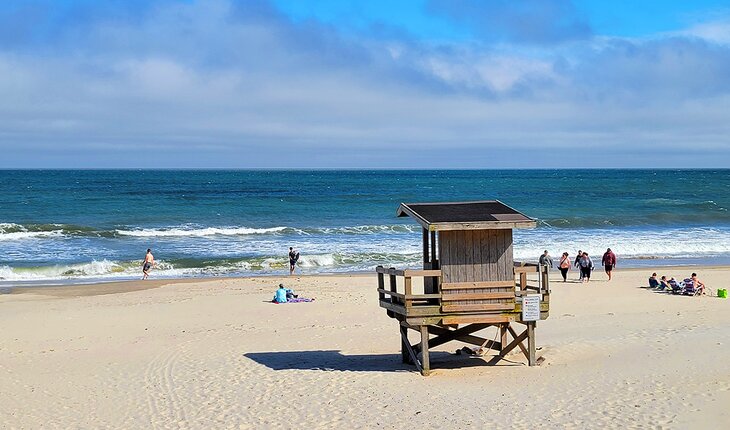
To experience what the Outer Banks used to be like before they became developed, hop a free and very scenic 75-minute ferry from Hatteras Island to Ocracoke. Here life moves at a slower pace and history abounds.
Once the haunt of notorious pirate Blackbeard, the island's main village is as authentic as it gets. Small eclectic stores, fantastic dining that ranges from high-end to casual, and seemingly endless beaches greet you and encourage you to explore.
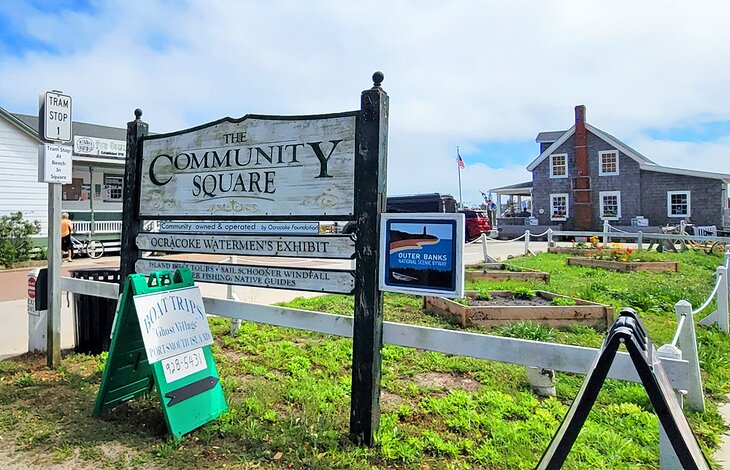
The pace of life on this island is slow and the speed limit in town is 20 miles per hour. If you don't feel like driving you can rent a golf cart to get around. In town, grab an ice cream or fudge, dine dock-side, and enjoy the sunset from the boardwalk behind the Ocracoke Island Discovery Center.
Other Popular activities include kayak tours on Silver Lake, a stop to see the Ocracoke Banker Ponies at the Pony Pen, walking in Springer's Point Preserve or the Hammock Hills Nature Trail, and of course, spending a day at the beach.
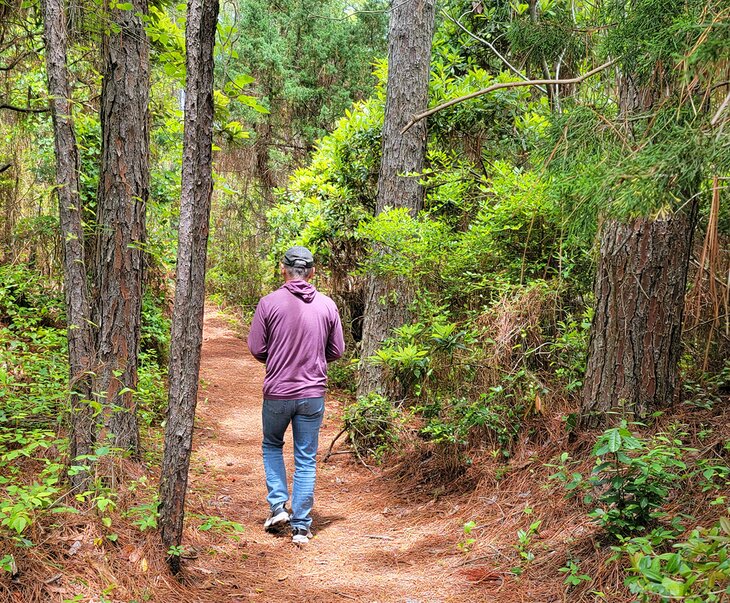
Ocracoke has plenty of accommodation, from hotels to vacation rentals, and a campground. All of these should be reserved in advance. If you are coming from the south, you can also take a ferry to Ocracoke from Cedar Island, but there is a fee for this and the crossing takes about 2 hours and 45 minutes.
Take a Boat Tour of the Outer Banks
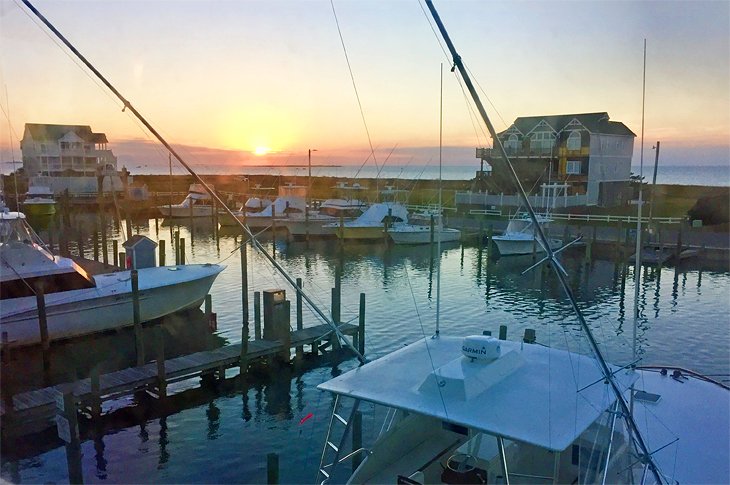
Most visitors to the Outer Banks cannot wait to get on the water in some way, which is why boat tours are popular. From adventure tours and sunset sails to airboat rides and even fishing charters, there is a boat excursion for just about every interest.
One of the most popular boating excursions is deep-sea fishing since Hatteras is one of the top fishing departure locations on the North Carolina coast. The best departure points for any of the boat tour excursions are Pirate's Cove, Oregon Inlet, and Hatteras.
If you depart from the Hatteras Marina be sure to grab dinner first at Dinky's Restaurant at the docks, where you can taste the day's freshest seafood. You will find local operators in each of those towns or you can stop by the Outer Banks Welcome Center to pick up pamphlets on regional operators.
See the Corolla Wild Horses
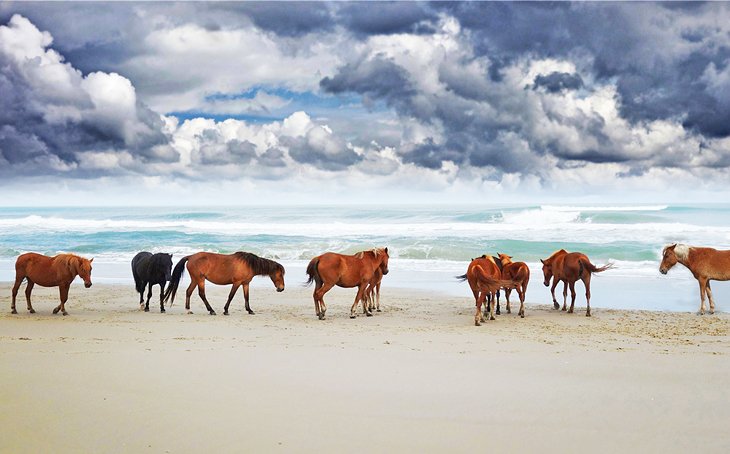
Where the blacktop of Highway 12 ends on the northern tip of North Carolina in Corolla is where you will discover the grace and beauty of the wild horses on the beaches. The Spanish mustang descendants run free and are sought out by photographers, painters, and writers who come to this coastal area for inspiration.
The mustangs have run free for five centuries after they were brought to this area from Spanish settlers. Seeing the wild horses is a bucket-list item for many people and one of the most unforgettable things to do in North Carolina.
Experiencing the wild horses requires a bit of planning since the area where they roam is off-road. You can explore on your own by renting a jeep, driving your own 4X4 with a permit, or taking a guided tour.
Explore the OBX on an Eco Tour
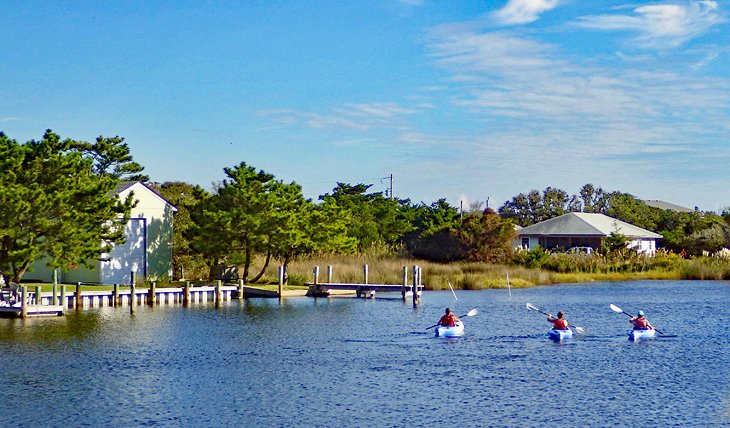
Eco-minded OBX (Outer Banks) vacationers and those who enjoy digging deeper into the natural scene will enjoy taking one of the many types of eco-tours available. One of the most popular is a Kitty Hawk Maritime Forest Kayak Tour.
This 1.5-hour guided tour takes you through the calm and peaceful waters of the Kitty Hawk Coastal Reserve. Wildlife is prolific with egrets, turtles, herons, and if you are lucky, playful river otters. The tour is family-friendly and suitable for all ages and levels.
See Marine Life at the North Carolina Aquarium
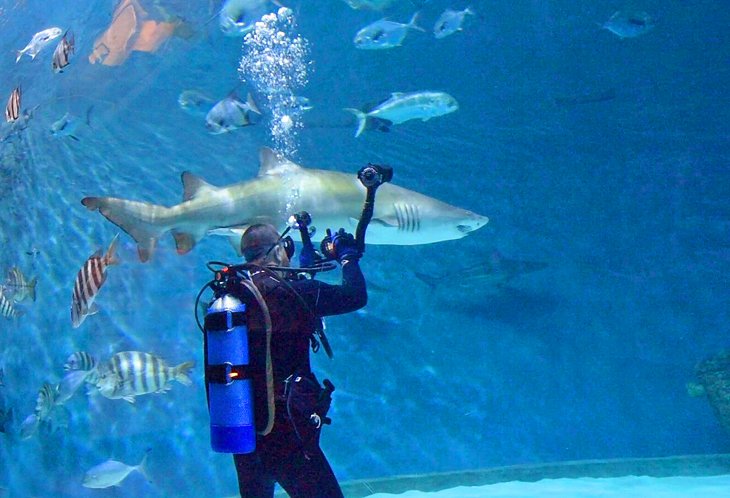
The Outer Banks caters to outdoor activities, but it is nice to have an indoor option like the North Carolina Aquarium on Roanoke Island in case of rainy weather or to cool off from the sun. See rescued sea turtles currently being rehabilitated in the STAR center and learn about their habitats along the Atlantic coast.
Explore the many exhibits and educational research taking place by aquarium scientists or plan to catch one of the free daily animal feedings and programs. For a unique visit, you can schedule a dive with the aquarium sharks...if you dare.
While you are on Roanoke Island, stop for lunch at O'Neal's Sea Harvest, where you can taste seafood fresh from the boat. O'Neal's supplies seafood to local restaurants but has a small dine-in area where you can try a mahi-mahi basket and maybe even see vessels arrive out back to unload their catch of the day.
Address: 374 Airport Road, Manteo, North Carolina
Chicamacomico Life-Saving Station Historic Site
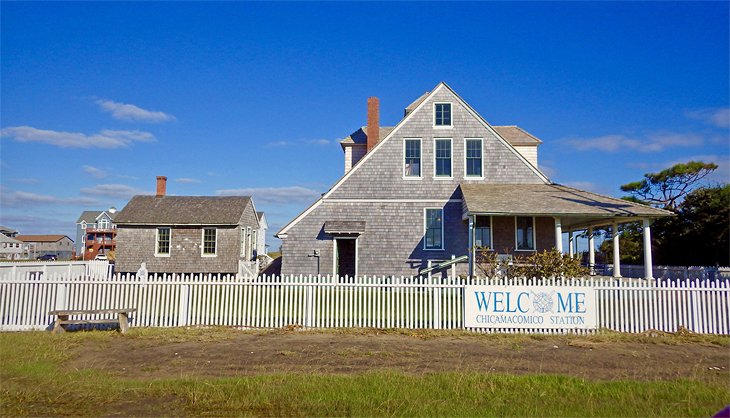
The Chicamacomico Life-Saving Station in Rodanthe is one of the top treasures of the Outer Banks. This popular tourist attraction is also a historical site and museum that will truly alter your perspective of place and provide important context to your visit.
The life-saving station was one of 271 around the country, created in 1871 with a single mission to search for and save seafarers in distress. This form of maritime rescue was eventually replaced by the Coast Guard when helicopters made ocean rescue easier than manual rescue by boat.
The Chicamacomico complex has several buildings to visit with actual life-saving relics and tools on display. The site was saved from demolition by a local grass-roots effort, and it accepts donations to keep it running.
It is now one of the only such life-saving stations that remain standing and the only one in North Carolina that operates as an educational museum. The best time to visit is on a Thursday at 2pm to experience a life-saving drill demonstration.
Address: 23645 NC Highway 12, Rodanthe, North Carolina
Tour the Graveyard of the Atlantic Museum
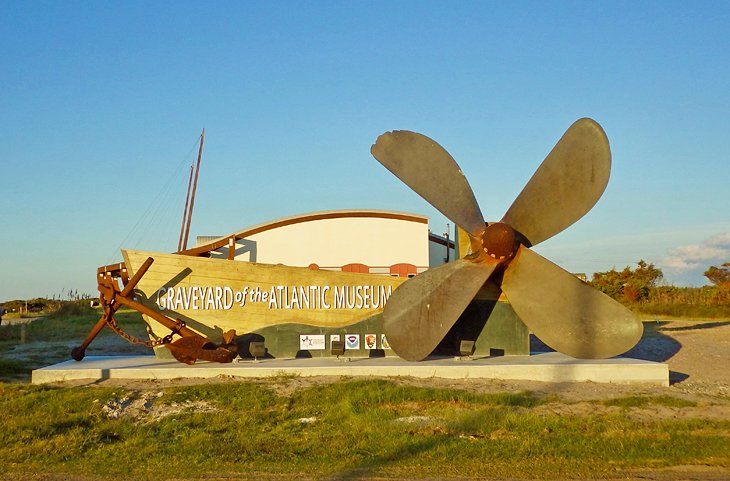
Just off the coast of the Outer Banks were thousands of shipwrecks over the centuries, and the Graveyard of the Atlantic Museum eloquently tells the stories of what happened to some of them. The museum displays artifacts from more than 2,000 shipwrecks off the North Carolina coast. Exhibits cover topics like ghost ships and piracy.
Two of the top things to see in the museum include the original Fresnel lens from the Cape Hatteras Lighthouse, which was lost for more than 140 years and was one of the first distress telegraphs sent by the Titanic to the Hatteras Weather Bureau in 1912.
Note: The Graveyard of the Atlantic Museum closed for renovations and the installation of new exhibits; re-opening in fall of 2023.
Address: 59200 Museum Drive, Hatteras, North Carolina
Take a Scenic Drive
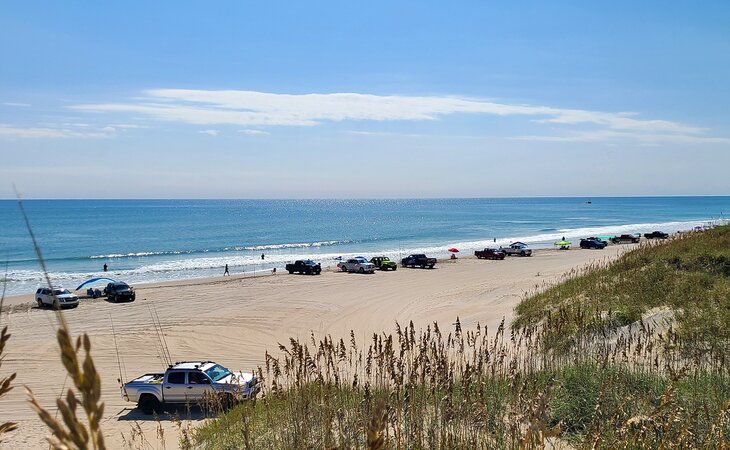
No matter where you stay, one of the highlights of a visit is to take a leisurely drive up or down the two-lane North Carolina Highway 12 along the Outer Banks. Along the way, explore the shops, towns, as well as the scenery, which alternates from raging surf along the Cape Hatteras National Seashore to the quiet Pea Island National Wildlife Refuge
Stop in and learn about the significant maritime history of the Outer Banks at Chicamacomico Lifesaving Station Historic Site and the Graveyard of the Atlantic Museum. Climb a lighthouse or two if you are feeling energetic, or bring a towel and umbrella and find your spot on a deserted beach. South of Salvo keep an eye out for colorful kites in the sky out over the water. These are kiteboarders riding some of the best waters in the United States.
A good place to start is the Outer Banks Welcome Center on Roanoke Island, here you'll find easy-to-read maps of the coast and all kinds of helpful advice.
Map of Attractions & Things to Do in the Outer Banks, NC
Best Time to Visit the Outer Banks
The best time to visit the Outer Banks is during the summer. In June, July, and August, the sun is hot, the water relatively warm, and the days long. Naturally, this brings out the crowds and increases the prices, but at the same time, it gives the Outer Banks a fun summertime vibe that's hard to beat.
Spring or fall are both good options as well. Everything is open and less crowded, and prices are somewhat lower. However, if you want to enjoy the ocean, fall is definitely the better option.
More Related Articles on PlanetWare.com

Explore More in North Carolina: Couples trying to plan a short trip can gain inspiration from our article on the Romantic Getaways in North Carolina.
Fishing is a popular sport here, both along the coast and in the mountains. Don't miss our piece on Deep Sea Fishing in North Carolina and our comprehensive article on Trout Fishing in North Carolina.


